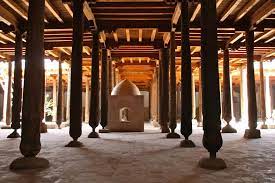SHARE WITH FRIENDS:
Khiva - Friday Mosque
Juma mosque is an architectural monument in Khiva (Khorezm) (X-XVIII centuries). In the central part of Ichan Castle, it is located on the street that connects Ota Gate and Polvon Gates. The first information about the Juma mosque is found in the writings of al-Muqaddas (al-Maqdisi) and al-Istakhri, Arab travelers who came to Khorezm in the XNUMXth century. According to sources, the original building of the Juma Mosque was demolished and replaced by a new mosque, built in the same way, by order of Abdurahman Mehtar (1788). The mosque is distinguished by its unique history and size. The mosque has one floor and is surrounded by a brick wall. It differs from other mosques in that it is built in the style of ancient Arab architecture (closed, multi-column and without a courtyard). It has no courtyard with porches, no huge roof, and no domed rooms. The interior of the room is illuminated by two holes in the ceiling. The roof is flat, beamed, and the ceiling is supported by 212 columns. The columns are 17 rows, spaced 3,15 × 3,15 m. The altar is located in the center of the south wall. The outer walls are simply unadorned. The main style door is a unique pattern carved in wood carving. The interior decorations are made of plain plaster. In the arch of the altar there is an Iraqi muqarnas and a blue painted pattern (belonging to the XVIII century). Columns not only form the basis of the structure of the mosque, but also its artistic decoration. They have a unique balance and look. Out of 212 columns, 25 columns of the X-XIV centuries are the oldest, and there are several patterns in their structure. 4 columns of X-XI centuries with deep embossed pattern, Kufic script combined with Islamic pattern. It is written that it was built by the order of the faqih Abul Fadal Muhammad Laysi. 17 columns of XI-XII centuries are relatively shallowly carved, the range of handicraft patterns is stylized, filled with botanical forms, inscriptions are written in Kufic script (not well preserved). sought Engraving ornaments in this style are found on wooden planks and door sills near the altar. In one of the columns mil. 1510y. saved. They can be installed at the same time as the marble slabs near the altar. On a small marble slab in 1666, a second marble slab inscription states that by order of Minister Abdurahman, foundation lands were allocated for mosques in the villages of Quyuqtom and Bekabad, and the proceeds should be used for charity and mosque needs (1788-89). The remaining columns were collected from various buildings in Khorezm. The lengths are cut to fit the construction of the mosque, and the short ones are mounted on a square stone base with carvings and heads. All columns are arranged on the basis of a specific sculpture. The minaret next to the mosque collapsed in the XNUMXth century and was rebuilt in the XNUMXth century from small bricks. The tower narrows upwards. The top is decorated with honor and brick dandana hoshiya belts.
tourist.com
